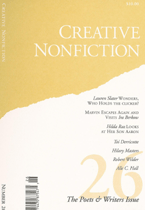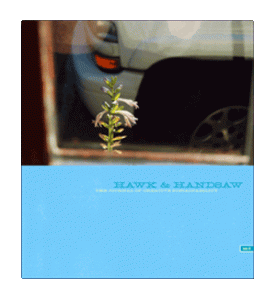Monkey Media
 Monkeybicycle has refitted their website, adding, among other things, a new media section featuring audio & video. Only two pieces of content available so far, but Laura van den Berg reading her new story “Photography” is worth a visit.
Monkeybicycle has refitted their website, adding, among other things, a new media section featuring audio & video. Only two pieces of content available so far, but Laura van den Berg reading her new story “Photography” is worth a visit.
3 x Canopy
 In case you have been living in an Internet & literature depressed world and have somehow missed Triple Canopy, here’s an introduction from their first issue. As we’ve said before, this magazine seems to be the greatest realization of the literary possiblities of online publishing. And, like Antioch Review (mentioned below), Triple Canopy is up this year for an Ellie.
In case you have been living in an Internet & literature depressed world and have somehow missed Triple Canopy, here’s an introduction from their first issue. As we’ve said before, this magazine seems to be the greatest realization of the literary possiblities of online publishing. And, like Antioch Review (mentioned below), Triple Canopy is up this year for an Ellie.
Follow Luna Park on Twitter
Yes, us too: http://twitter.com/lunaparkreview![]()
Antioch Review Up for Ellie
 The Antioch Review is a finalist in the “essays” category for the 44th annual National Magazine Award. (See our previous post on the NM Awards.) It is the magazine industry’s highest award and has been compared to the movie industry’s “Oscar” competition. The twenty-six winners will receive an “Ellie” designed by Alexander Calder at an event on April 30th at New York’s Jazz at Lincoln Center, Frederick P. Rose Hall. The Antioch Review’s entry was an essay/memoir piece “Vickie’s Pour House: A Soldier’s Peace” by Maureen McCoy, Professor of English at Cornell University. The essay appeared in the winter 2008 issue of the Review. Robert S. Fogarty, editor of The Antioch Review, said “it was a distinct honor to be chosen in a category where there is stiff national competition.”
The Antioch Review is a finalist in the “essays” category for the 44th annual National Magazine Award. (See our previous post on the NM Awards.) It is the magazine industry’s highest award and has been compared to the movie industry’s “Oscar” competition. The twenty-six winners will receive an “Ellie” designed by Alexander Calder at an event on April 30th at New York’s Jazz at Lincoln Center, Frederick P. Rose Hall. The Antioch Review’s entry was an essay/memoir piece “Vickie’s Pour House: A Soldier’s Peace” by Maureen McCoy, Professor of English at Cornell University. The essay appeared in the winter 2008 issue of the Review. Robert S. Fogarty, editor of The Antioch Review, said “it was a distinct honor to be chosen in a category where there is stiff national competition.”
Literal Latte Anthology Out
 Literal Latté has a new interactive website, where readers can comment/converse about the readings (click above link or picture at left to visit site). Below is a word from the magazine’s editors about their new anthology…
Literal Latté has a new interactive website, where readers can comment/converse about the readings (click above link or picture at left to visit site). Below is a word from the magazine’s editors about their new anthology…
The anthology contains over 40 works from lesser-known authors. While many established writers helped support the literary magazine through the years, its real goal was to promote unknown authors, although some of them have become well-known, like Julia Glass, who won the National Book Award after being published in Literal Latte. Thus, it is their works that are found on the pages of the anthology. Serving as a celebration of the previous 15 years of publishing, the anthology will endear long-time fans and captivate first-time readers.
One Story: Introducing New Writers
 A brief note from One Story:
A brief note from One Story:
One Story would like to take a moment to announce the publication of our next issue, “Hurt People.” This story is by Cote Smith, a previously unpublished author.
At One Story, we are committed to discovering new talent and showcasing original voices. For this reason, One Story will never publish an author more than once. We are proud to say that 10% of our writers are published for the first time in our pages.
This issue marks the launch of our “Introducing New Writers” series. “Hurt People” will arrive in a custom envelope, marking it as a fiction debut and inviting subscribers to congratulate the author on our blog.
We will host a reading in Lawrence, Kansas–where Cote Smith is finishing his MFA in fiction writing–in May. As part of this series, we will be hosting hometown readings for writers who publish for the first time in One Story in 2009. This is made possible by a generous grant from the National Endowment for the Arts.
We hope you enjoy “Hurt People” and the introduction of a bright new literary voice.
Creative Nonfiction and Poetry
 In honor of National Poetry Month, for the rest of April Creative Nonfiction will be offering Issue 26: The Poets and Writers Issue for half price.
In honor of National Poetry Month, for the rest of April Creative Nonfiction will be offering Issue 26: The Poets and Writers Issue for half price.
This issue features many writers whose work crosses the borders between literary genres, from poetry and fiction to creative nonfiction, and illustrates how the lines of division between writers may be disintegrating.
The stories themselves also flirt with the idea of crossing boundaries – between life and death, between countries and cultures and languages, and between individuals.
Featuring work by Hilary Masters, Ira Berkow, Toi Derricotte, Lauren Slater, and more.
For more information or to buy a copy, click here.
Enviro Lit Mag
 Last year Unity College published their first issue (image at right) of Hawk & Handsaw: The Journal of Creative Sustainability. According to its website, Unity College is “America’s Environmental College.” An overstatement? Who knows, but certainly a step in the right direction. And such Pangea-oriented thinking is at the heart of Hawk & Handsaw. Here’s a bit from the editorial introduction to the issue:
Last year Unity College published their first issue (image at right) of Hawk & Handsaw: The Journal of Creative Sustainability. According to its website, Unity College is “America’s Environmental College.” An overstatement? Who knows, but certainly a step in the right direction. And such Pangea-oriented thinking is at the heart of Hawk & Handsaw. Here’s a bit from the editorial introduction to the issue:
Hawk & Handsaw is committed to leaving the smallest environmental footprint possible. In preparing for the publication of this issue, we spent at least as much time deliberating over how to construct it as we did what to include within it. In the end, we struck a compromise we think embodies a lived sustainability. The paper you hold is manufactured by Boise Cascade and contains a minimum of 30% post-consumer fiber; the remaining 70% is harvested from mix-sourced stands certified by the Forestry Stewardship Council. Both are processed using biogas energy. There are paper products out there with higher post-consumer content—and some that may score higher green ratings. We remain committed, however, to the idea of access for our readers and, in the end, decided that making the price of this journal affordable for the everyday subscriber is an important part of sustainability, too.
Economy—another kind of oikos—also dictated our printing values. We have partnered with a community designer and nearby printer for the production of this journal. Doing so helps support the local business economy and reduces the overall carbon footprint of this publication.
2009 National Magazine Awards
The 2009 National Magazine Awards have been particularly kind to literary magazines and their writers. Here are some, I think, notable finalists:
- For General Excellence (under 100,000 circ.): The American Scholar and Virginia Quarterly Review;
- For Essays: The Antioch Review for Maureen McCoy’s “Vickie’s Pour House: A Soldier’s Peace“;
- For Fiction: The American Scholar for Charles Baxter’s “Royal Blue” and Jim Shepard’s “Happy with Crocodiles,” The New Yorker for Roberto Bolano’s “Clara” (along with 3 other story nominations for the magazine), The Paris Review for Alistair Morgan’s “Departure” and Damon Galgut’s “The Lover,” and Virginia Quarterly Review for Sana Krasikov’s “Asal” and Kanishk Tharoor’s “Tale of the Teahouse“;
- For General Excellence Online (less than 1,000,000 monthly visitors): Triple Canopy.
If anything comes out of these nominations, I hope it is more recognition for the fantastic work being done at Triple Canopy. Better than most online publications, they work with the Internet medium (as opposed to treating it like a print medium), resulting in some fantastic issues to date.
Writing Crime
 Yesterday the new issue of Lapham’s Quarterly hit the newsstands, “Crimes and Punishments.” Taking the usual model of looking at historical documents concerning the theme, this issue uses writing by Hardwick, Delillo, Angelou, Hitchens, Kafka, Cheever, and others to explore the 20th century’s dominant dramatic theme: the mythification of crime. Editor Lewis Lapham’s introduction explains that, because of America’s long romance with criminals and justice, we can see its expression even in the current recession: “Transferred into the pitiless deserts of finance and politics, the American romance with crime excites the adoration of the Wall Street magi, as wasteful and unremorseful as tigers, notable during the whole of the country’s history for their robbing of widows and beggaring of orphans, made in the image of Russell Sage and Jay Gould, of whom it was said in the 1870s, ‘When they speak they lie; and when they are silent they are stealing.’”
Yesterday the new issue of Lapham’s Quarterly hit the newsstands, “Crimes and Punishments.” Taking the usual model of looking at historical documents concerning the theme, this issue uses writing by Hardwick, Delillo, Angelou, Hitchens, Kafka, Cheever, and others to explore the 20th century’s dominant dramatic theme: the mythification of crime. Editor Lewis Lapham’s introduction explains that, because of America’s long romance with criminals and justice, we can see its expression even in the current recession: “Transferred into the pitiless deserts of finance and politics, the American romance with crime excites the adoration of the Wall Street magi, as wasteful and unremorseful as tigers, notable during the whole of the country’s history for their robbing of widows and beggaring of orphans, made in the image of Russell Sage and Jay Gould, of whom it was said in the 1870s, ‘When they speak they lie; and when they are silent they are stealing.’”
On a side note: Emily Wilkinson’s prize winning book review from the Winter 2009 issue of Virginia Quarterly Review handily explains the Victorian origins of literature’s obsession with murder and detectives in Kate Summerscale’s The Suspicions of Mr. Whicher. From the review: “Victorian England, however, offered crimes of an intricacy, horror, and premeditation that made the pickpockets and highwaymen of preceding ages look quaint. True to de Quincey’s aesthetics of crime, “design” came to the fore: Jack the Ripper marked the bodies of his young female victims with signature mutilations (throats cut to the spine; a kidney, heart, or a part of the womb removed), and in the plots of crime’s new fictional counterpart, detective fiction, authors like Wilkie Collins and Arthur Conan Doyle wove elaborate webs of hatred, desire, betrayal, want, and fear that created, sometimes concealed, and—once unraveled—identified criminals.”
